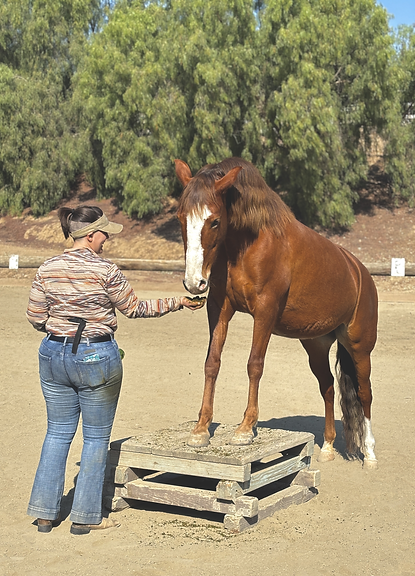
Positive Reinforcement
Rather than use force with horses, my method of choice to encourage cooperation during a trim is by using R+.
Positive reinforcement (R+) is a science-based approach that uses an appetizing reward to reinforce a behavior. When the horse demonstrates a behavior we want, such as holding up the hoof, we use a marker (a clicker, cluck, or "yes!") to mark the correct behavior. This is then followed with a reward (I use lower value treats such as hay pellets & beet pulp).
For horses that have mild difficulty standing for the farrier such as fidgeting, stomping, a busy mind, are young, or refuse to pick up their feet, I often find the most success with introducing food rewards during the session.
Most horses will immediately respond positively and stand better than they ever have! This is the trick up my sleeve I prefer to use rather than using force with horses. A positive experience makes for a safer visit for both trimmer and horse. Most horses respond immediately during a trim and do not need separate training sessions.
If your horse still demonstrates difficulty standing for the farrier, I recommend a thorough veterinary consultation to check for pain & discomfort.


Training to Stand
It can be a challenge to train your horse to stand for their hoof care on your own! There are so many tools, variables, and an expensive hoof stand that can be hard to replicate at home. Oasis is here to help.
Oasis offers cooperative care sessions ($45/each) using R+ to create a positive association with the trimmer, the hoof stand, tools, and the physical requirements of the horse to stand for a trim.
This is a great tool for horses that are new to trimming such as young horses, mustangs, or horses that have had some negative experiences with past trimmers.
Success will greatly rely on the whole care team of the horse. A thorough vet examination is required after the evaluation and before the cooperative care sessions begin, particularly if the horse is exhibiting new unwanted behaviors.
We do this on a case-by-case basis and not every horse's journey looks the same. For more information and to see if your horse is a good candidate, please contact us for an evaluation.
Note: Training cannot be effective with pain present. A thorough vet examination is required to investigate for pain & discomfort. An equine behaviorist is also recommended for cases that involve trauma & aggression.
The success of this training will rely on the homework done by the owner in addition to the sessions.